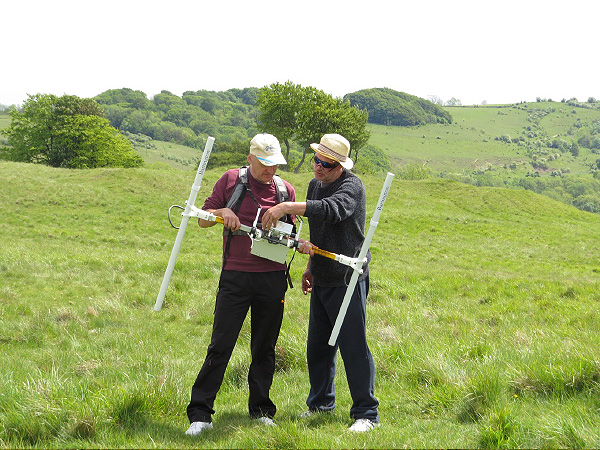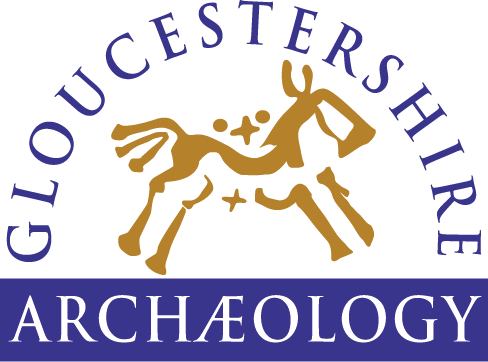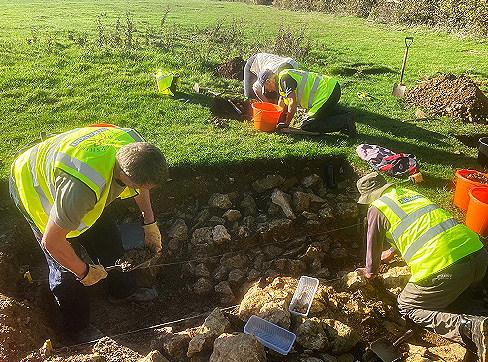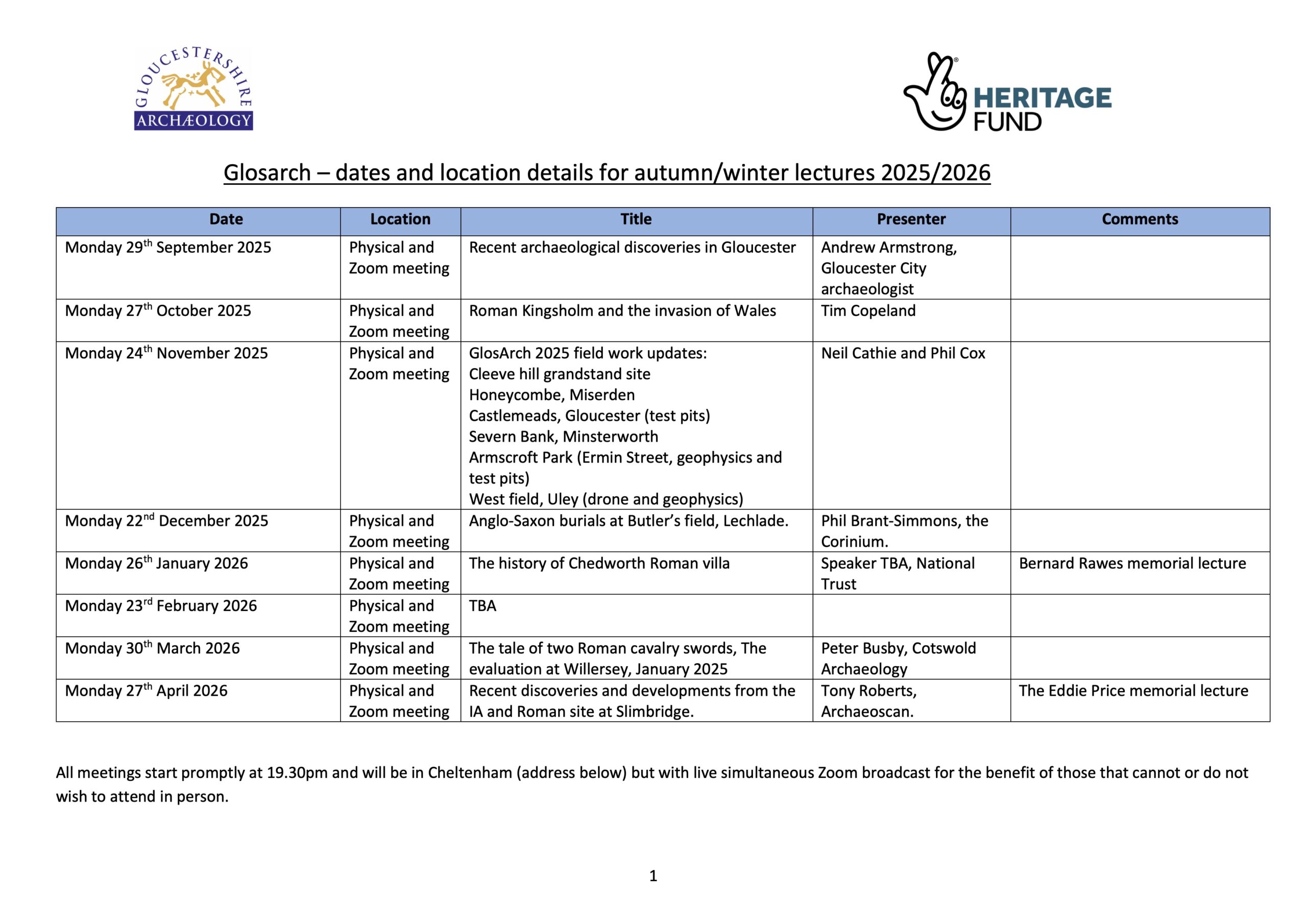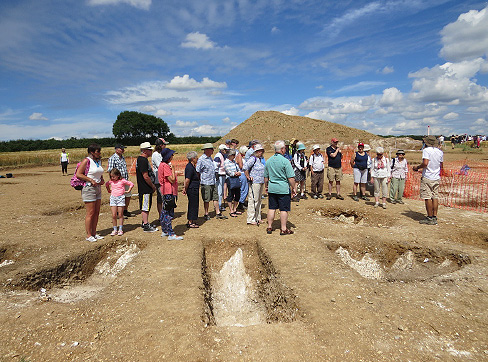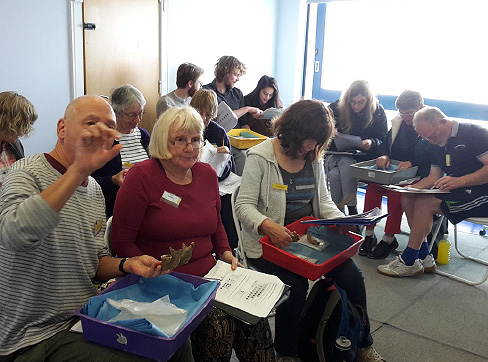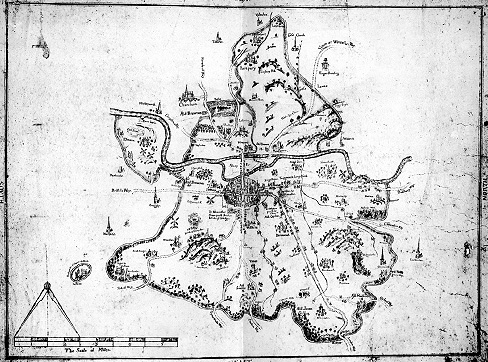Welcome to GlosArch
The website of Gloucestershire Archaeology
GlosArch (Gloucestershire Archaeology) is a local archaeology society with a mission to widen public knowledge of the fabulous archaeology and history of the county of Gloucestershire. Between September and April we hold an monthly series of public lectures by guest speakers on a range of archaeological and historical topics and in the summer we run a programme of visits to sites of interest. In addition, we have an active programme of archaeological fieldwork for members, both excavation and geophysical surveying, and run an osteoarchaeology recording group. No previous experience is needed to take part in these activities.
We publish a newsletter twice a year and our annual journal, Glevensis, which is in its 56th edition, carries reports on archaeological and historical topics by professional and amateur researchers.
If you share our passion for the past, why not join us?
Latest News
For more information, see ‘Winter lectures and summer visits’ below.
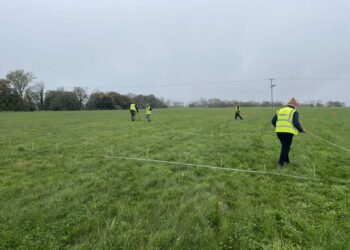
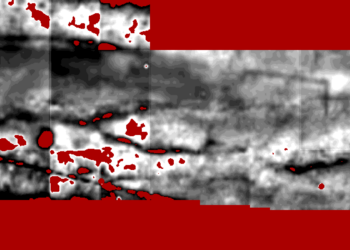
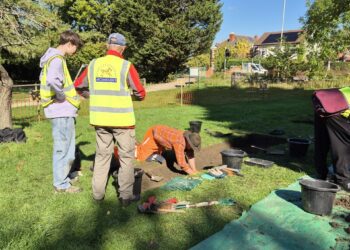
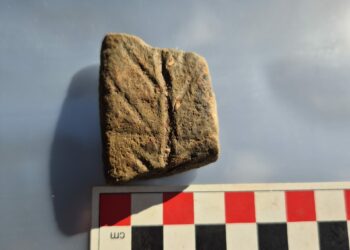
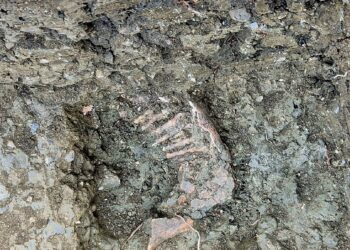
I am excited to announce that a Young Archaeologists Club is starting soon at Gloucester Cathedral. It will be launching on Saturday 18th October with a session exploring artefacts, archaeological archives and the Gloucester Discovery Centre.
YAC Gloucestershire is open to anyone aged 8-16 and is free to attend. Sessions will be on Saturdays approximately 10am-1pm, once a month. If anything is different they will give at least one months’ notice, in person and via email. For safeguarding and safety purposes and their records, all members guardians’ will be required to fulfil an intake form before starting.
For more information and the intake form please contact education@gloucestercathedral.org.uk. Information about YAC and the group can be found at: Gloucestershire YAC – Young Archaeologists’ Club – Archaeology for you
There are also several exciting family days coming up at the Cathedral over the autumn term including on Tuesday 28th October 11-3pm – Remembrance Family Day
Explore War and Peace and Memory with activities designed for children to explore the recent past and remembrance. No booking required
The Cathedral is also hosting an evening of remembrance poetry which will take place on Wednesday 15thOctober, 18.30 – 21.00. Free to attend, no booking required. This will feature pieces by Ivor Gurney, the Dymock Poets and original pieces written and performed by: Stewart Carswell, Julie Wiltshire, TSantana, Richard Illingworth, JLM Morton, Merce Jade, Adam Horovitz, Lt Cdr Jonathan Aylett, ZZulu and Kathryn Southworth
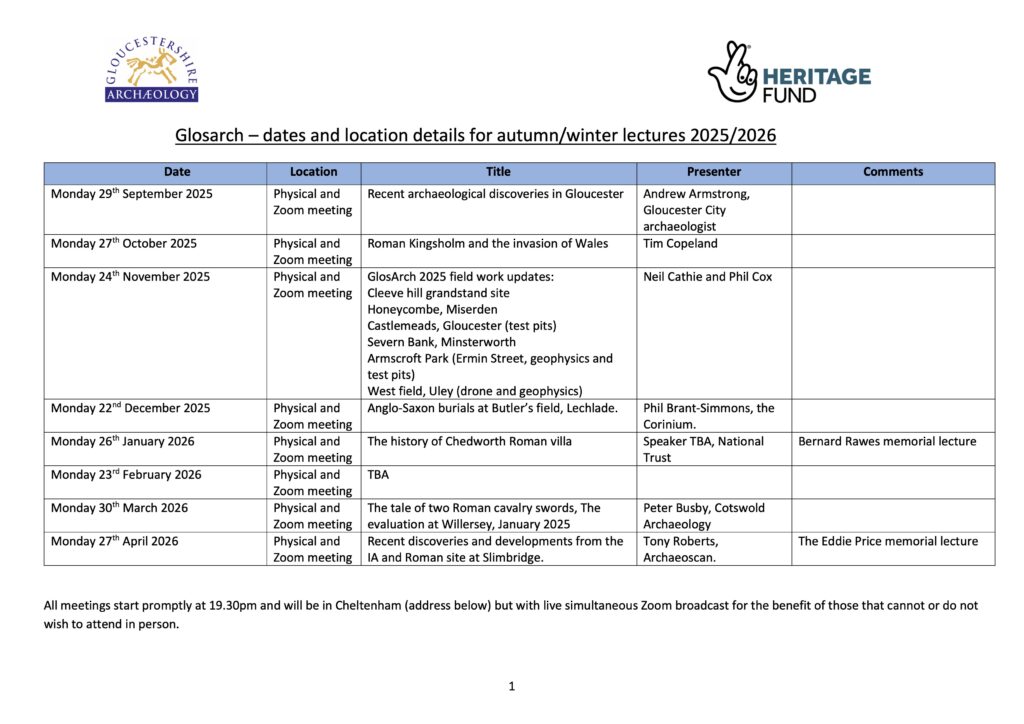
Newsletter – Autumn 2025
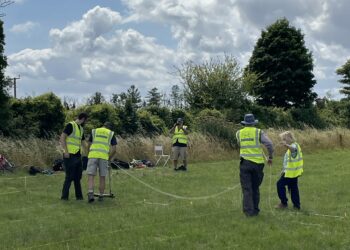
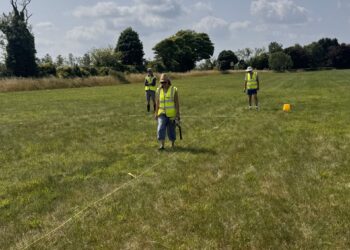
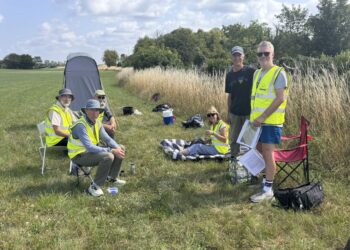
Cleeve Hill Grandstand Excavation
The site has been photographed, drawn and GPS’d and thanks to some brilliant volunteers has been backfilled and returfed.
We are very grateful to #CotswoldArchaeology for sending Anton Beechey to record the site using a high resolution GPS, and then take some amazing images with their drone.
We are building a better picture of the building and hope to return in 2026 to explore the inside and some other features of interest.
We had loads of passing interest in what we were doing. If you would like to join us and take part in our future digs, go to Membership Sign-up and get involved.

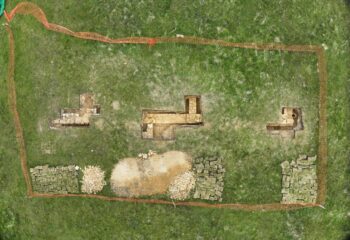
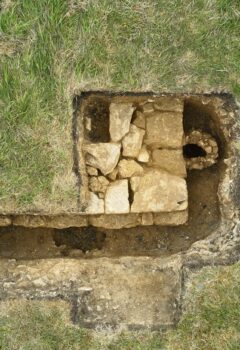
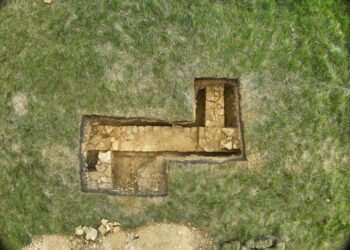
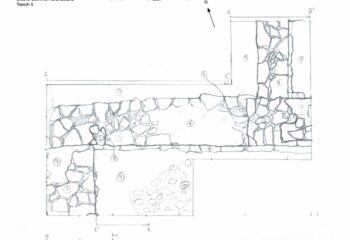
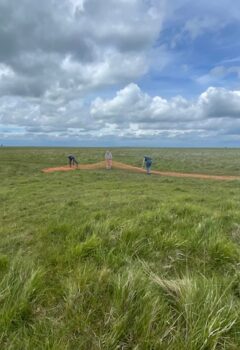
Cleeve Hill Grandstand Excavation
Sunday 25th May 2025
In no time at all it is over for this year! Over four days, around 20 volunteers undertook 37 person-days of excavation of the front wall of the grandstand of Cheltenham’s first racecourse, near the top of Cleeve Hill.
We uncovered both ends of the foundations of the front wall and also identified the position of the main doorway, along with a number of other interesting features, helping us build up a picture of what this grand, but short-lived building would have looked like. We recovered lots of coloured wall plaster, mouldings, possibly skirting boards, a few pieces of glassware and pottery and a single sequin!
All that remains is for us to measure, draw and photograph the site and then fill it all back in again. We hope to be back next year to find out more about the interior of the building, to help us to complete the picture.
We had loads of passing interest in what we were doing. If you would like to join us and take part in our future digs, go to Membership Sign-up and get involved.
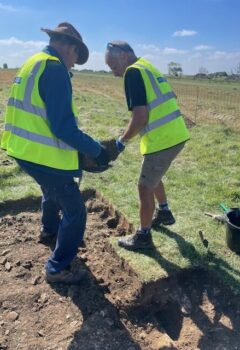
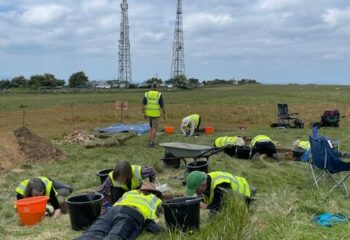

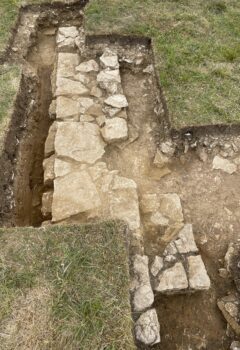
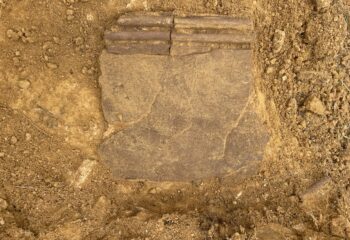
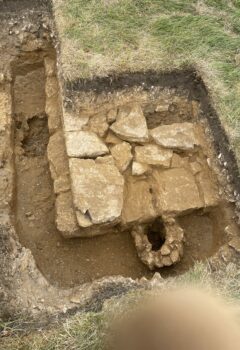
Grant Award by Jockey Club from GC100 Fund
GlosArch is excited to announce that we have been awarded £2000 a grant of from the Gold Cup 100 Community Grant Initiative administered by the Jockey Club and Rotary Clubs of Cheltenham. The grant is to support post-excavation analysis of finds from the excavation of the Cleeve Common Racecourse grandstands and the creation of a digital 3D reconstruction of the building based on the evidence we uncover. This will be available to view via our website and on the Common.
Forthcoming Activities
Winter Lectures and Summer Visits
GlosArch members can access the archive of recorded lectures by logging in to their account on the website and going to Resources>Recorded Lecture Archive.
Summer Visits 2025
The Summer visits programme for 2025 has been arranged by David Jones who has taken over the organiser’s role.
Withington Roman Villa.
Date TBC
We will be taken on a guided tour of the recent excavations by archaeologist Simon Greenslade. This site comprises two Romano-British building complexes surviving as buried masonry with associated field boundaries and trackways situated on a limestone plateau. The first villa was excavated in 1811 by Samuel Lyons and again in 2006. At this time geophysical survey showed the second even larger building complex nearby which was also excavated. Simon Greenslade is leading the latest excavation of the site
September/ October. Date and time TBC depending on ongoing work.
Completed visits
Rollright Stones, North Leigh Roman villa and Witney
The annual coach trip was well attended. We were treated to a tour of the stones led by Tim Copeland, followed by a visit to North Leigh Roman villa, where the volunteer guides showed us the site and its mosaic and Tim Copeland explained the significance of the site and its relation to the Roman road network. We finished with a well-earned cup of tea in Witney, before returning home.
Churchdown Hill
Michael Hare, Phil Cox and Mike Joy took us on a walk around the top of this Cotswold outlier and its church, St Bartholomew’s. Michael explained why the church may be where it is and how it sits on a man-made mound. We then went to see the Iron Age ramparts, which indicate the presence of a small hillfort. We ended with a tour of the church which has many interesting features. Thanks to the Friends of St Bartholomew’s for giving us access.
Crickley Hill – Revisited – New Date – Friday 1st August, 6pm
The earliest evidence of human activity on Crickley Hill dates back to the early Neolithic, around 6,000 years ago, when it was the site of one of the most important causewayed enclosures in the country. Later in the Neolithic around 2500BC, saw the building of cairns and a long mound on the promontory. After the abandonment of the Neolithic site, Crickley may have lain deserted for more than a thousand years. In the Iron Age, from about 700 BC onwards, a hillfort was built on Crickley Hill. This survived for around 100 years before being destroyed. The defences were reinforced and the site resettled around 500BC, but this too was abandoned. The site has seen farming, battles, sacred worship, tribal gatherings and settlements.
GlosArch have a long association with Crickley Hill going back to the time of Director of Excavations, Professor Philip Dixon MA D.Phil FSA FRHS, who kindly led the guided walk, which was attended by 35 members and guests. Phil’s deep insight to the site from the Mesolithic and Neolithic, through the Iron Age and beyond resulted in a fascinating and thoroughly enjoyable, if slightly chilly, evening.
Volume 3 of the excavation report, as well as previous volumes, can be purchased by going to: http://crickley.org/crickley/Publications.html. Volume 3, The Long Mound Valley, describes the Long Mound, Stone Circle, related monuments and the Short Mound
For reports on the 2024 visits please see the Autumn Newsletter, available to download by going to Publications/Newsletter Home.
If you have a suggestion for a visit in 2025, please drop me an email at mailbox@glosarch.org.uk
2025-26 LECTURE SERIES
The programme for the 2025-26 lecture series, is coming together and will be published in the next few weeks. Lectures are free to members and non-members (non-members are invited to make a small donation towards the cost of running the talks – £5 is suggested). Payment can be made by bank transfer to Gloucestershire Archaeology; Sort code 08-92-99; A/c no. 67285787.
As before, the venue for in-person attendance is St Andrews URC church hall, Montpellier St, Cheltenham, GL50 1SP. The lecture will also be broadcast on Zoom. GlosArch members will receive the Zoom link automatically a few days before the lecture. Non members can request the Zoom link by emailing: mailbox@glosarch.org.uk
To get a flavour of the range of topics covered in previous years click on Lectures below and follow the link.
Fieldwork
To take part, email fieldwork@glosarch.org.uk (members only).
Fieldwork Programme 2025
Plans are coming together for the 2025 fieldwork season. On the excavation front we will be returning to Cleeve Hill, Honeycombe and Severn Bank, Minsterworth. The centrepiece of the geophysics will be a major survey near Uley.
If you wish to volunteer for any of these activities, please email fieldwork@glosarch.org.uk with your preferred dates. Depending on the number of volunteers, it may be necessary to restrict the number of days individual participants can take part, to maximise the number of members that can be involved.
FORTHCOMING ACTIVITIES
Uley – West Hill Roman temple
We will be continuing our geophysical surveying of West Hill Uley on 11th, 14th and 16th of October, extending the surveys adjacent to areas of interest identified in August.
Members wishing to take part are asked to email fieldwork@glosarch.org.uk stating which days they wish to volunteer for. No previous experience is needed to take part.
RECENT FIELDWORK
Excavations
Armscroft Park, Gloucester
On 22nd and 23rd September, GlosArch volunteers undertook a small excavation in Armscroft Park Gloucester, to investigate the remains of Roman Ermin Street on behalf of Andrew Armstrong, Gloucester City archaeologist. Over the two days we excavated three trenches and identified a surface, likely to relate to the road, along with a range of pottery, appearing to date from modern times, back to the Bronze Age.
Severn Bank, Minsterworth
After a year off, we returned to Severn Bank between 17th-20th August. After a very dry summer the conditions were very challenging as the clay was hard-baked. Despite this the volunteers located some interesting features including some foundation remains and a burnt post hole. For a short report see the the latest GlosArch Newsletter at https://glosarch.org.uk/newsletter-home/
Castlemeads – Test pitting
Following a series of geophysical surveys of earthworks on Castlemeads, Gloucester, as part of the Gloucester Festival of Archaeology, on Sunday 20th July, we undertook a one-day test pitting excavation over some of the most prominent features.
We found lots of evidence of Victorian activity on the site, but no structural remains. The mystery remains!
Honeycombe, Miserden
22nd, 23rd, 27th and 28th June 2025.
This activity is now complete. Thanks to everyone who took part and helped to make such great progress with the excavation. Most of the building has now been excavated and has been recorded. A short report will appear soon on the fieldwork page.
Cleeve Hill – The grandstand of Cheltenham’s first racecourse.
Sunday 18th, Monday 19th, Friday 23rd and Saturday 24th May.
This activity is now complete. See above for a brief summary of the dig.
We intend to return to the site in 2026 to complete the investigation of the layout of this interesting site, with the aim of producing an interactive 3D visualisation of the building which will be publicly available.
Geophysics
Uley – West Hill Roman temple
Between 9-11th August GlosArch volunteers undertook the first phase of a geophysical survey on West Hill Uley, adjacent to the site of the Uley Roman shrines, with the aim of identifying traces of buildings associated with the shrines.
Over the three days the amazing team of volunteers surveyed more than 56oom2 with magnetometry and resistivity. Despite the dry conditions the surveys appear to show evidence of structures beneath the ground. We aim to return in the next couple of months to extend the survey area. The results will help Historic England in their review of scheduled monuments.
Armscroft Park, Gloucester
On Wednesday 16th and Thursday 17th July we undertook a small geophysical survey in Armscroft Park Gloucester, looking for traces of Roman Ermin Street, which runs through the park.
Our results confirm the position of the Roman road, but show it is likely to be heavily disturbed.
Resistivity and Magnetometry Survey in Leckhampton.
In December we undertook a small resistivity survey in the garden of a Georgian house in Leckhampton, Cheltenham. The results showed evidence of lost features including a formally laid out garden at the rear and evidence of a possible carriage circle relating to an earlier building. Further investigation is being planned.
Ground Penetrating Radar Survey at Castlemeads, Gloucester. 19th and 21st August, 2024
This activity is complete.
In collaboration with Exeter University we have undertaken a GPR survey of the features on Castlemeads, Gloucester in the area previously examined by resistivity and magnetometry. we have identified some shallow sub-surface solid structures as well as the electric cables and some other much deeper features. Further work is being considered.
Magnetometry Surveying at Castlemeads, Gloucester
This activity is now complete.
In rather wet conditions and after having to abandon the original survey due to flooding (it is on a flood plain after all) we managed to complete the magnetometry survey on a chilly, slightly damp December day.
The results show a number of underground electricity cables but also features which appear to correspond to the LIDAR images. The findings were presented at our members update meeting on 18th December.
Geophysics Training
If you are interested in receiving training on our geophysics equipment, please contact Phil Cox via: fieldwork@glosarch.org.uk as a further session can be arranged if there is demand.
Uncovering our Past Together
New Members Welcome
From students to seasoned experts, GlosArch welcomes people of all ages and experience to join us!
Benefits of becoming a member include...
Become a GlosArch Member
If you are interested in the archaeology or local history of Gloucestershire, join us, at GlosArch (Gloucestershire Archaeology), and help to discover the past.
Whatever your experience you can participate in excavations, fieldwalking, geophysical surveying, document research and historic building recording. There are lectures and site visits to attend and help and advice given on finds processing and pottery, coin and artefact identification and recording.
